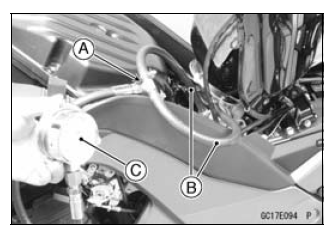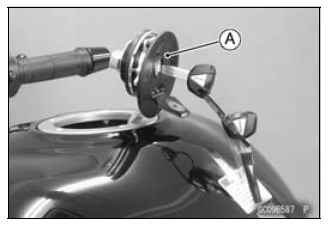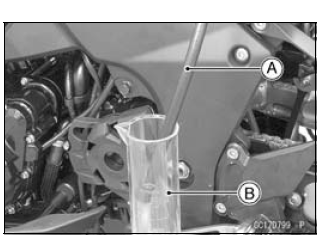 Kawasaki Z1000SX - Service manual > Fuel Line
Kawasaki Z1000SX - Service manual > Fuel Line
Fuel Pressure Inspection
NOTE
- Be sure the battery is fully charged.
- Remove: Fuel Hose (see Fuel Hose Replacement in the Periodic Maintenance chapter)
- Support the fuel tank with a suitable bar (see Fuel Tank Removal in the
Fuel System (DFI) chapter).
- Be sure to place a piece of cloth around the fuel outlet pipe of the fuel pump and the delivery pipe of the throttle body assy.
WARNING Fuel is flammable and explosive under certain conditions and can cause severe burns. Be prepared for fuel spillage; any spilled fuel must be completely wiped up immediately. When the fuel hose is disconnected, fuel spills out from the hose and the pipe because of residual pressure. Cover the hose connection with a piece of clean cloth to prevent fuel spillage.
- Install the fuel pressure gauge adapter [A] and fuel hoses (Special Tool: 57001-1607) [B] between the fuel outlet pipe and delivery pipe.
- Secure the fuel hoses with the clamps.
- Connect the pressure gauge [C] to the fuel pressure gauge adapter.
Special Tools -
Oil Pressure Gauge, 5 kgf/cm²: 57001-125
Fuel Pressure Gauge Adapter: 57001-1593
Fuel Hose: 57001-1607

WARNING Fuel is extremely flammable and can be explosive under certain conditions resulting in serious injury or death. Do not try to start the engine with the fuel hoses disconnected.
- Connect the fuel pump lead connector.
- Turn the engine stop switch run position.
- Turn the ignition switch ON.
- The fuel pump should operate for 3 seconds, and then should stop.
NOTE
- After turning on the engine stop switch and ignition switch, inspect the fuel leakage from the connected portion of the special tools.
NOTICE Do not drive the fuel pump 3 seconds or more without the fuel in the fuel tank. If the fuel pump is driven without the fuel, it may be damaged.
- Start the engine, and let it idle.
- Measure the fuel pressure with the engine idling.
Fuel Pressure (with Engine Idling)
Standard: 294 kPa (3.0 kgf/cm², 43 psi)
NOTE
- The gauge needle will fluctuate. Read the pressure at the average of the maximum and minimum indications.
- Turn the ignition switch OFF.
If the fuel pressure is much higher than specified, replace the fuel pump because the fuel pressure regulator in the fuel pump have been clogged or stuck.
If the fuel pressure is much lower than specified, check the following.
Fuel Line Leakage (see Fuel Injector Fuel Line Inspection)
Amount of Fuel Flow (see Fuel Flow Rate Inspection) - After above checks, measure the fuel pressure again.
- Remove the fuel pressure gauge, hoses and adapter.
- Install:
Fuel Hose (see Fuel Hose Replacement in the Periodic Maintenance chapter)
Fuel Tank (see Fuel Tank Installation) - Confirm that the drain hose and clamp are installed securely and run the hose correctly (see Cable, Wire, and Hose Routing section in the Appendix chapter).
- Start the engine and check for fuel leakage.
Fuel Flow Rate Inspection
WARNING Gasoline is extremely flammable and can be explosive under certain conditions, creating the potential for serious burns. Make sure the area is well-ventilated and free from any source of flame or sparks; this includes any appliance with a pilot light. Do not smoke. Turn the ignition switch OFF.
Be prepared for fuel spillage; any spilled fuel must be completely wiped up immediately.
NOTE
- Be sure the battery is fully charged.
- Turn the ignition switch OFF.
- Wait until the engine cools down.
- Prepare a fuel hose (Special Tool: 57001-1607) and a measuring cylinder.
Special Tool - Fuel Hose: 57001-1607
- Support the fuel tank with a suitable bar (see Fuel Tank Removal in the Fuel System (DFI) chapter).
- Open the fuel tank cap [A] to lower the pressure in the tank.
- Remove the fuel hose from the fuel pump (see Fuel Tank Removal)
- Be sure to place a piece of cloth around the fuel outlet pipe of the fuel pump.
WARNING Fuel is flammable and explosive under certain conditions and can cause severe burns. Be prepared for fuel spillage; any spilled fuel must be completely wiped up immediately. When the fuel hose is disconnected, fuel spills out from the hose and the pipe because of residual pressure. Cover the hose connection with a piece of clean cloth to prevent fuel spillage.

- Connect the prepared fuel hose [A] to the fuel outlet pipe.
- Secure the fuel hose with a clamp.
- Insert the fuel hose into the measuring cylinder [B].
WARNING Wipe off spilled out fuel immediately.
Be sure to hold the measuring cylinder vertical.
- Close the fuel tank cap.
- Turn the engine stop switch to run position.
- Turn the ignition switch ON.
- The fuel pump should operate for 3 seconds, and then should stop.

NOTICE Do not drive the fuel pump 3 seconds or more without the fuel in the fuel tank. If the fuel pump is driven without the fuel, it may be damaged.
- Measure the discharge for 3 seconds.
- Repeat this operation several times.
Amount of Fuel Flow
Standard: 50 mL (1.7 US oz.) or more for 3 seconds
- Turn the ignition switch OFF.
If the fuel flow is much less than the specified, replace the fuel pump (see Fuel Pump Removal/Installation).
- Install the fuel tank (see Fuel Tank Installation).
- Confirm that the drain hose and clamp are installed securely and run the hose correctly (see Cable, Wire, and Hose Routing section in the Appendix chapter).
- Start the engine and check for fuel leakage.
See also:
 Kawasaki Z1000SX - Service manual > ECU
Kawasaki Z1000SX - Service manual > ECU
ECU Identification Most countries have their own regulations, so each ECU has different characteristic. So, do not confuse ECU with each other and use only the ECU for your model. Otherwise, the motorcycle cannot clear the regulation.
 Kawasaki Z1000SX - Service manual > Fuel Pump
Kawasaki Z1000SX - Service manual > Fuel Pump
Fuel Pump Removal WARNING Gasoline is extremely flammable and can be explosive under certain conditions, creating the potential for serious burns. Make sure the area is well-ventilated and free from any source of flame or sparks; this includes any appliance with a pilot light. Do not smoke. Turn the ignition switch OFF.
 Rider's Manual BMW R 1250 GS GSA
Rider's Manual BMW R 1250 GS GSA Owner's Manual Harley-Davidson Sportster XL1200X Forty-Eight
Owner's Manual Harley-Davidson Sportster XL1200X Forty-Eight Owner's Manual Honda CBR650R
Owner's Manual Honda CBR650R Service manual Honda CBR650
Service manual Honda CBR650 Owner's Manual Honda PCX125
Owner's Manual Honda PCX125 Owner's Manual Kawasaki Z1000SX
Owner's Manual Kawasaki Z1000SX Service manual Kawasaki Z1000SX
Service manual Kawasaki Z1000SX Owner's Manual Lexmoto Echo
Owner's Manual Lexmoto Echo Owner's Manual Royal Enfield Interceptor 650
Owner's Manual Royal Enfield Interceptor 650 Service manual Royal Enfield Interceptor 650
Service manual Royal Enfield Interceptor 650 Owner's Manual Yamaha MT-07
Owner's Manual Yamaha MT-07